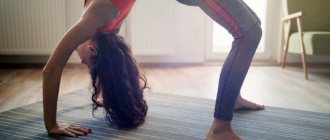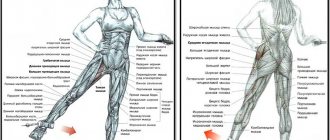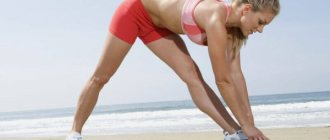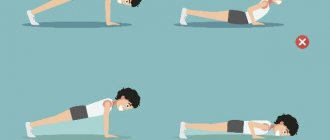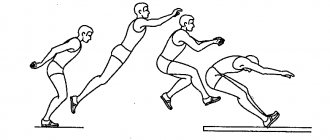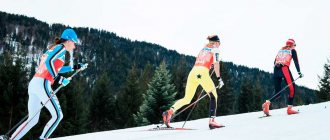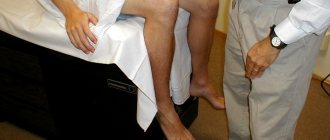Today's beauty standards and the flashing of long-legged models on the catwalk bring a lot of frustration to average girls and women who are dissatisfied with their appearance and proportions. They try at any cost to resemble the ready-made standards of beauty presented to them. To be perfect, they undertake any operations and risks.
You can lengthen your legs not only through surgery
Today, many girls are worried about the seemingly impossible task of changing the natural length of their legs. I don’t really want to advise poor things to go under the surgeon’s knife. Maybe this problem can be solved in a less bloody way? How to lengthen your legs without surgery, at home?
Ways to lengthen legs at home
In most cases, women's dreams of plastic surgery are unfounded: beauty is not a standard norm, and we are beautiful precisely because of our differences. And the beauty of the body is not the size of the waist or the length of the legs.
Body beauty - in the right proportions
This truth was known to ancient sculptors, who proved that a small, plump woman can be no less beautiful than the long-legged huntress Diana. Therefore, before you decide to lengthen your legs, take a close look at yourself in the mirror: perhaps, despite your small height, your legs are actually long (in accordance with your proportions)?
But to the point. You still can’t convince a woman: if she decides to lengthen her legs, she will do it at any cost.
Surgical intervention
The operation is performed using the so-called Ilizarov apparatus. A specialist manually makes a fracture in the hip or tibia area, and then the bones begin to recover. At the same time, the length in the fracture area begins to increase.
Surgeries are often prescribed for patients with impaired leg growth and deformity. This procedure is very expensive and time-consuming, and the recovery period after it lasts about one year. In addition, surgery aimed at lengthening the lower extremities is completely prohibited in case of poor blood clotting, pathologies of the skin, chronic forms of diseases and disorders of the central nervous system.
The operation consists of several stages:
- On the first, special fixing rods are placed in the limb.
- At the next stage, the medical specialist performs an osteotomy, that is, dissecting the bone tissue.
- A week later, the device is installed on the leg. The limb lengthens by about one millimeter per day, and the entire process will take from fifty to one hundred and fifty days.
- The device is not removed until the bone has completely healed.
This operation can guarantee excellent results; your legs will certainly become longer. However, after it a long recovery is required. In addition, there is a risk of complications that can negatively affect the quality of subsequent life or even contribute to the patient’s disability. Therefore, surgical intervention is resorted to in exceptional situations.
Lengthening your legs with exercise
Let us reassure fashionistas: it is indeed possible to “grow” your legs a little at home. However, no “folk methods” in the form of herbs, rubbing, eating grated carrots, or spells will work here.
The easiest way to lengthen your legs is to load yourself with daily physical activity. No, bodybuilding is definitely not suitable here. The problem is solved much easier with the help of stretching exercises for the thigh and calf muscles.
Daily jogging is a great way to lengthen your legs.
Examples of simple exercises
- Jogging, but, of course, not in heels, and also not in slippers or flip-flops: Shoes should be regular sports shoes, without any frills: you can use regular sneakers, but sneakers are more comfortable and healthier for your feet.
- if you walk on your toes every day for at least 15 – 20 minutes;
- Extend your arms in front of you parallel to the floor or a couple of centimeters higher.
- Holding the back of a chair or the crossbar of a gymnastic ladder, we slowly move our leg back and as high as possible.
- The starting position is the same as in the previous exercise.
- Your task is to stretch your leg as high as possible with a sharp movement, while simultaneously making a pushing movement, simulating a kick.
Rehabilitation period
After the procedure, recovery occurs, which lasts from six months to a year. Due to the fact that the patient experiences a lack of physical activity, his muscles weaken significantly and need to be strengthened through physical exercise. If the rehabilitation period does not proceed very well, then bone fractures and other damage in the area of osteosynthesis are likely in the future.
The doctor also prescribes physiotherapeutic procedures that will help accelerate the healing of tissue fibers, and massage that improves nutrition and blood circulation. During rehabilitation, the patient must adhere to a special diet that will speed up the process.
How to lengthen your legs with stretching (splits)
This is the most difficult exercise, crowning the entire complex of training for lengthening the legs.
In order to fully do the splits, you need long training
Before performing this, please read the warning:
- Do not try to do full stretching right away in the first classes - this is dangerous!
- The splits are also not performed on cold muscles - start it after a preliminary warm-up.
- The exercise should also not be done if you have serious orthopedic problems or injuries.
Stretching training technology - in the video below:
Video: Stretching at home
Is height enhancement surgery safe?
One of the key points that patients are interested in before height increase surgery (leg lengthening surgery) is safety. How safe is surgery to increase height using the Veklich apparatus, judge for yourself:
- practical experience in performing osteotomies for more than 40 years;
- favorable outcome in the vast majority of patients (99%);
- improved design that reduces the risk of infection and injury during surgery. By the way, the needles in the Ilizarov apparatus can touch arteries or nerve endings, causing irreparable harm. The Veklich apparatus eliminates this factor;
- an accelerated rehabilitation period, which returns the patient to a normal lifestyle after 6-7 months, reduces the psychological discomfort associated with wearing a fixation device;
- minimally invasiveness ensures minimal blood loss and the absence of large open wounds;
- 100% biocompatible. Unlike implants or metal rods, height is increased due to the addition of one's own natural bone tissue, which is completely suitable for the patient, without the risk of rejection.
Despite all the benefits and extensive experience of surgical interventions, there are always risk factors. In 99% of cases, the operation is successful and the results last a lifetime. But there are some contraindications, so you need to undergo a full examination before going on the operating table.
Special exercises to change leg length
Women often ask whether hanging on a horizontal bar helps lengthen their legs. There is no particular difference between hanging on a gymnastic ladder and hanging on a horizontal bar.
Any hanging, with a load or not, lengthens not only the legs, but also the torso, and in general the proportions of the entire body do not change.
If a woman is determined to lengthen only her legs, leaving the length of her body the same, then it is better to replace hanging on a bar or horizontal bar with exercises on a chair with weights or an inversion table.
Chair exercises
For this exercise, a chair with a high seat, where your feet will not touch the floor, is suitable.
Caution: The use of weights for rheumatoid arthritis or deforming arthrosis of the knee joint can be dangerous. Be sure to consult your doctor if you have these diseases.
Exercises on an inversion table
This is also hanging, but upside down while holding it with your legs - in this position, stretching of the bones and joints of the legs occurs due to the force of gravity.
On an inversion table, leg exercises are performed upside down.
- If you don’t have an inversion table, you can use either a horizontal bar or an Evminov prophylactic.
- All exercises upside down on the horizontal bar must be performed in inversion boots.
Consequences and complications of different leg lengths
The difference in leg length leads to a number of pathological conditions:
- back pain;
- spinal deformity and pelvic distortion;
- deforming arthrosis and aseptic necrosis in the hip joint;
- stress fractures;
- disturbance of gait and statics;
- violation of ergonomics, muscle imbalance;
- associated injuries due to limited compensation options.
Distortion of the pelvis and deviation of the spine with different leg lengths of 6 cm. a - without compensation; b - with compensation of 3 cm; with 6 cm compensation.
The same amount of difference in leg length has a more detrimental effect on a child’s body than on an adult’s body. This is due to different widths of the pelvis. In children, the pelvis is narrow, so the centers of the femoral heads are close, so the angle of the pelvis and the deviation of the spine will be greater.
A complex of pathological disorders that develop due to differences in leg length is what some authors call “unequal leg length syndrome.” If left untreated, leg length differences can cause many functional compensatory conditions (eg, spinal deformity) to transform into irreversible fixed deformities (scoliosis).
S-shaped scoliosis formed as a result of an uncompensated difference in leg length of 10 cm in a 40-year-old patient
Treatment tactics for identifying different leg lengths
Congenital shortening of the legs in children, due to the fact that the bones of the lower limb are of different lengths, requires observation for 6-12 months in order to determine the rate of growth lag in the leg and, most importantly, to get answers to the following questions:
- to operate or not;
- at what age should the operation be performed;
- lengthen a shortened leg or shorten a longer one;
- if lengthened, by what amount, etc.
Acquired differences in leg length as a result of a fracture or damage to the growth plate require compensation as early as possible
Post-traumatic shortening of the right femur in a 15-year-old patient, which led to pelvic deviation and spinal deformity. Femoral lengthening resulted in complete recovery.
There is a misconception that you have to wait until you are 16-18 years old to have reconstructive surgery. In case of pronounced shortening (more than 3 cm), the operation must be performed as early as possible - at the age of 6-7 years, so that the child does not feel inferior at school.
True shortening in adults is most often associated either with diseases that remain from childhood, or belongs to the so-called category. acquired. As a rule, such “acquisitions” are the consequences of injuries or operations. Shortenings are often combined with post-traumatic deformities. Adults adapt much worse to this pathological condition and come to the idea of the need for surgical treatment earlier.
What is the principle of limb lengthening based on?
Regardless of the specific lengthening technique, the general principle of limb lengthening is based on the discovery of G.A. Ilizarov “The general biological property of tissues to respond to stretching with growth and regeneration.” Those. if the limb is gradually stretched in the Ilizarov apparatus (1 mm per day), then the muscles, blood vessels, nerves, and skin will gradually stretch and lengthen without losing their properties. In order to stretch the bone, it must be crossed. This procedure is called an osteotomy. With gradual stretching, the increasing distance between the bone fragments in the osteotomy area is filled with newly formed bone tissue - regenerate.
Tibia regenerate in the process of lengthening the tibia by 7 cm
We offer you the most modern methods of lengthening, which can significantly reduce the time of fixation with the Ilizarov apparatus and begin early rehabilitation (express methods with fixation with an intramedullary pin).
About the results of leg lengthening at home
Many women do not have enough patience in their studies and very often they exclaim:
- My God! I’m already suffering so much, but I haven’t grown a centimeter and nothing has lengthened!
But when the girl is asked how much “that much” is, it turns out that she had been practicing, horror of horrors, for two whole weeks.
Daily leg measurements are a waste of time
So, beauties, the first result after daily training will appear after two to three months, and a more noticeable result will appear after six months. And then measuring your legs every day with a centimeter is a waste of time. The best analyzer is a mirror. Rate yourself:
If you yourself have become slimmer and fitter, then your legs will visually look longer.
Some people make a different kind of mistake:
It is recommended to do exercises with weight-bearing loads for 10-15 minutes a day, and they do it for half an hour, hoping that the higher the load, the sooner and more they will be able to lengthen their legs. The result is burst blood vessels in the legs, pain in the bones and muscles, and general fatigue, which kills further desire to exercise.
There is no way to storm or rush here.

